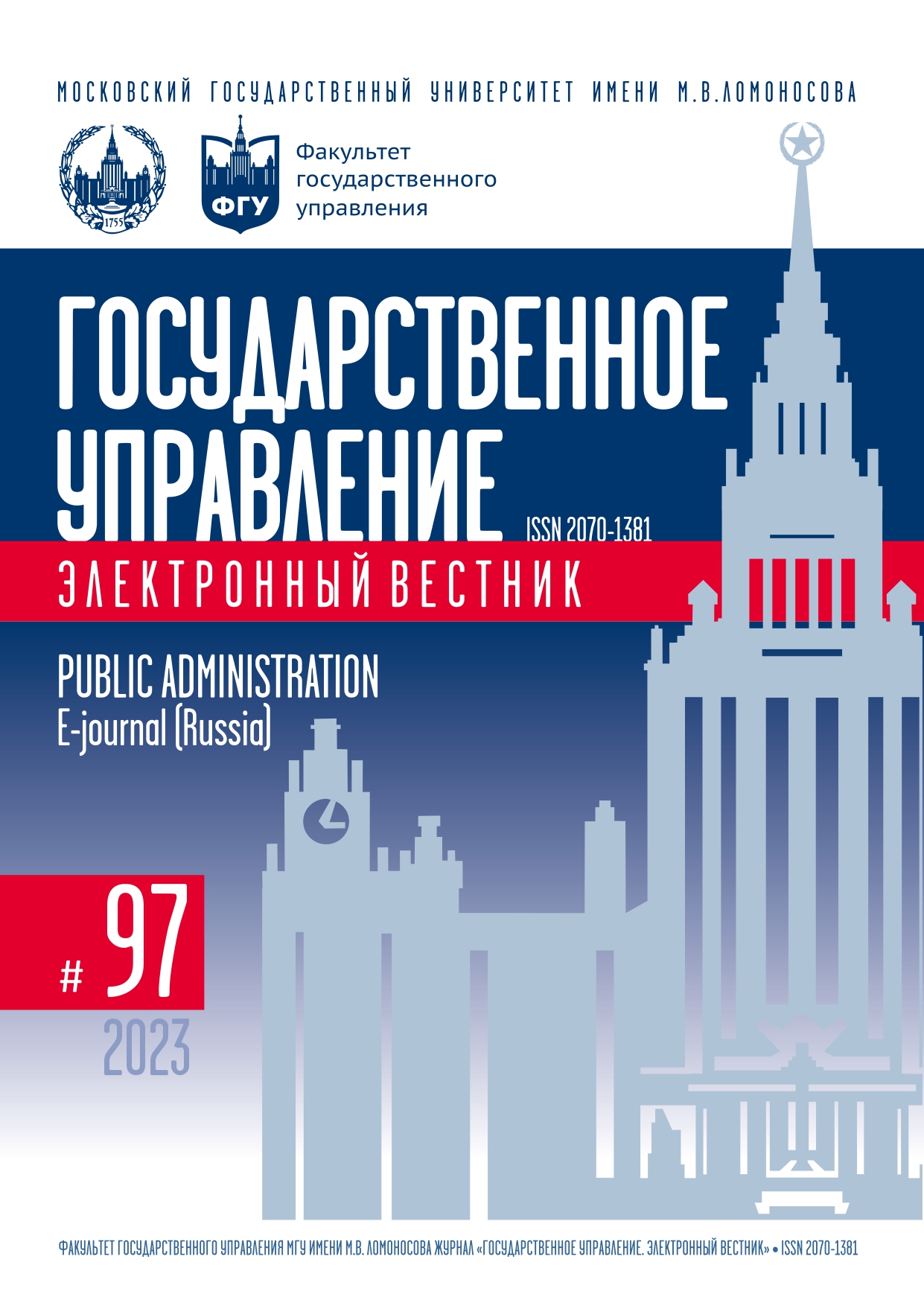Нейроинтерфейсы в государственном управлении: возможности и ограничения
DOI:
https://doi.org/10.24412/0s6z3j40Ключевые слова:
Нейротехнологии, нейроинтерфейс, нейрокоммуникации, нейросенсинг, нейродискриминация, нейробезопасностьАннотация
Изучение современной номенклатуры нейроинтерфейсов направлено на определение технологических горизонтов
трансформации государственного управления, при этом особую актуальность оно приобретает в связи с принятием дорожной карты развития «сквозной» цифровой технологии «Нейротехнологии и искусственный интеллект». Пристальное внимание к развитию нейротехнологий отражает стремление Правительства Российской Федерации качественно отреагировать на рост мирового рынка нейроинтерфейсов и на суверенной технологической основе осуществить инновационный переход к новой системе взаимодействия «человек–машина», предоставив государственным служащим возможность более эффективного совершения административных операций. В этой связи целью исследования является раскрытие и визуализация технических возможностей и ограничений, потенциальных рисков от внедрения нейроинтерфейсов в практику государственного управления. С учетом роста программно-технических решений на базе нейротехнологий методы исследования включают в себя когнитивный метод, оценивающий технологические способы применения и вероятные негативные последствия от внедрения нейротехнологий; метод визуализации механизмов и технологий внедрения нейротехнологий как на уровне программных решений, так и на технологическом уровне нейроинтерфейсов; метод экспертного опроса представителей академического сообщества России с использованием Google-таблиц. Результаты проведенного исследования говорят о том, что при всем разнообразии развития нейротехнологий в сфере государственного управления в ближайшие годы могут успешно внедряться технологии компьютерного зрения по идентификации и верификации личности, технологии интеллектуального анализа и синтеза речи, технологии рекомендательных систем и создания виртуальных помощников, технологии межмашинного обучения, технологии нейроуправления коммуникациями и двигательной активностью человека, технологии нейротрекинга, когнитивного усиления и создания смешанных человеко-машинных команд. Потенциальные негативные последствия от внедрения нейротехнологий в практику государственного управления определяют направления дальнейших исследований нейроинтерфейсов, касающихся вопросов обеспечения нейробезопасности, защиты от нейродискриминациии алгоритмической предвзятости, прогнозирования эффектов нейростимуляции и когнитивного улучшения, сохранения нейропсихической неприкосновенности человека и целостности его нейрографического профиля.
Библиографические ссылки
Бодин О.Н., Солодимова Г.А., Спиркин А.Н. Нейроинтерфейс для управления роботизированными устройствами // Измерение. Мониторинг. Управление. Контроль. 2019. № 4 (30). С. 70–76. DOI: 10.21685/2307-5538-2019-4-8
Ганин И.П., Каплан А.Я. Изучение эффектов вариативности потенциалов мозга человека в интерфейсе мозг-компьютер на волне Р300 // Вестник Российского государственного медицинского университета. 2022. № 3. С. 78–85. DOI: 10.24075/vrgmu.2022.033
Данилевский В.Я. Исследования над физиологическим действием электричества на расстоянии. Том 2. Дальнейшие опыты по нейро-электрокинезу. Харьков: Паровая Типо-Литография М. Зильбергеръ и С-вья, 1901
Кравченко С.В., Каде А.Х., Трофименко А.И., Вчерашнюк С.П., Малышко В.В. Когнитивное нейропротезирование — путь от эксперимента к клиническому применению // Инновационная медицина Кубани. 2021. № 3. С. 64–72. DOI: 10.35401/2500-0268-2021-23-3-64-72
Миронов В.И., Лобов С.А., Крылова Н.П., Гордлеева C.Ю., Каплан А.Я., Буйлова Т.В., Бахшиев А.Б., Щуровский Д.В., Вагнер В.О., Кастальский И.А., Ли А.Н., Казанцев В.Б. Разработка нейроуправляемого автомобиля для мобилизации людей с двигательным дефицитом — нейромобиля // Современные технологии в медицине. 2018. Т. 10. № 4. С. 49–59. DOI: 10.17691/stm2018.10.4.06
Сеченов И.М. Рефлексы головного мозга // Медицинский вестник. 1863. № 47. C. 461–484; № 48. C. 493–512.
Спешилова Н.В., Андриенко Д.А., Рахматуллин Р.Р., Спешилов Е.А. Анализ и оценка горизонтов применения технологии нейроинтерфейса при реализации концепции «Индустрия 4.0» в конкурирующем мировом экономическом пространстве // Вестник Евразийской науки. 2019. № 2. URL: https://esj.today/52ecvn219.html
Филипова И.А. Нейротехнологии: развитие, применение на практике и правовое регулирование // Вестник СПбГУ. Право. 2021. Т. 12. № 3. С. 502–521. DOI: 10.21638/spbu14.2021.302
Филипов И.А. Нейротехнологии в праве и правоприменении: прошлое, настоящее и будущее // Правоприменение. 2022. Т. 6. № 2. С. 32–49. DOI: 10.52468/2542-1514.2022.6(2).32-49
Berger H. Über das Elektroenzephalogramm des Menschen // Archiv für Psychiatrie und Nervenkrankheiten. 1929. Bd. 87. № 1. S. 527–570.
Bryndin E. Communication of Internal Speech with Communicative Associative Robot via Spectral Neurointerface // Electrical Science and Engineering. 2021. Vol. 3. Is. 1. P. 16–22. DOI: 10.30564/ese.v3i1.3255
Caton R. Electrical Currents of the Brain // The Chicago Journal of Nervous and Mental Disease. 1875. Vol. 4. Is. 2. P. 610.
Cinel C., Valeriani D., Poli R. Neurotechnologies for Human Cognitive Augmentation: Current State of the Art and Future Prospects // Frontiers in Human Neuroscience. 2019. Vol. 13. DOI: 10.3389/fnhum.2019.00013
Delgado J. Physical Control of the Mind: Toward a Psychocivilized Society. New York: Harper & Row, 1969.
Gao X., Wang Y., Chen X., Gao S. Interface, Interaction, and Intelligence in Generalized Brain–Computer Interfaces // Trends in Cognitive Sciences. 2021. Vol. 25. Is. 8. P. 671–684. DOI: 10.1016/j.tics.2021.04.003
Kennedy P., Bakay R. Restoration of Neural Output from a Paralyzed Patient by a Direct Brain Connection // Neuroreport, 1998. Vol. 9. Is. 8. P. 1707–1711. DOI: 0.1097/00001756-199806010-00007
Ma Q., Gao W., Xiao Q., Ding L., Gao T., Zhou Y., Gao X., Yan Y., Liu Ch., Gu Z., Kong X., Abbasi Q.H., Li L., Qiu Cg-W., Li Y., Cui T.J. Directly Wireless Communication of Human Minds via Non-Invasive Brain-Computer-Metasurface Platform // eLight. 2022. Vol. 2.
DOI: 10.1186/s43593-022-00019-x
Nemminski W.W. Ein Versuch der Registrierung der elektrischen Gehirnerscheinungen // Zentralblatt für Physiologie. 1913. Bd. XXVII. S. 951–960.
Reymond E. Reden von Emil Du Bois-Reymond. Leipzig: Verlag von Veit and Comp., 1912.
Tzovara A., Chavarriaga R., De Lucia M. Quantifying the Time for Accurate EEG Decoding of Single Value-Based Decisions // Journal of Neuroscience Methods. 2015. Vol. 250. P. 114–125. DOI: 10.1016/j.jneumeth.2014.09.029
Valeriani D., Cinel C., Poli R. Group Augmentation in Realistic Visual-Search Decisions via a Hybrid Brain-Computer Interface // Scientific Reports. 2017. Vol. 7. DOI: 10.1038/s41598-017-08265-7




